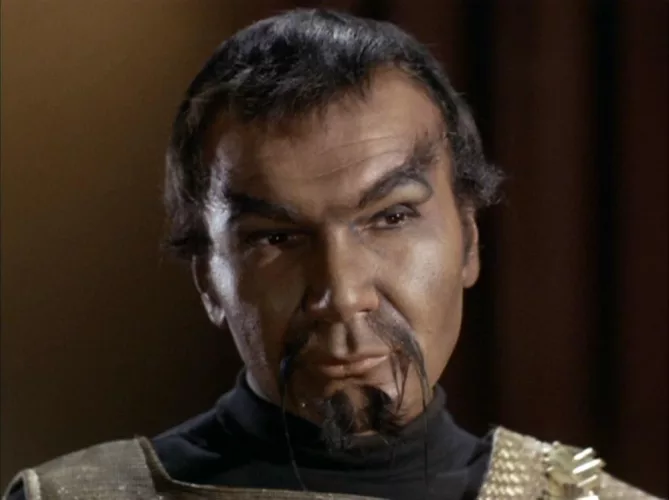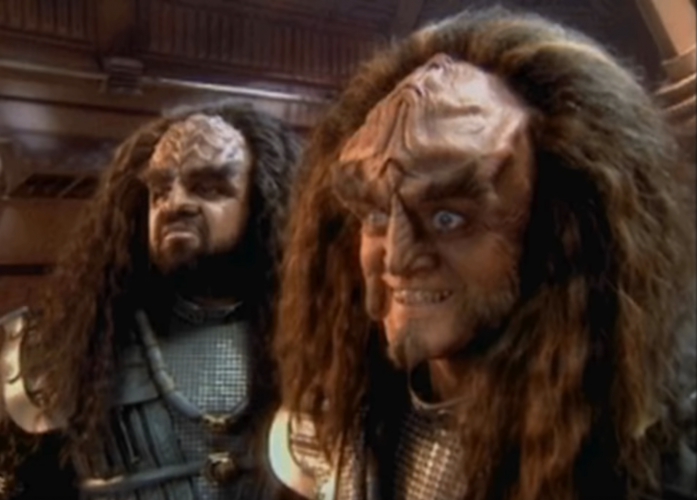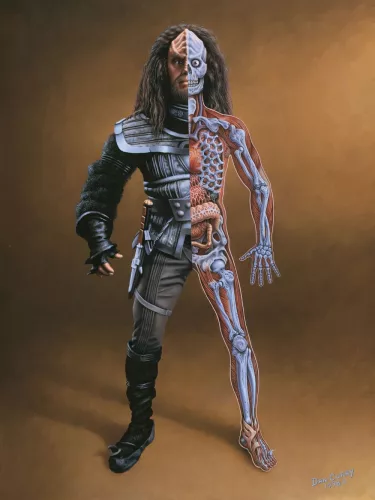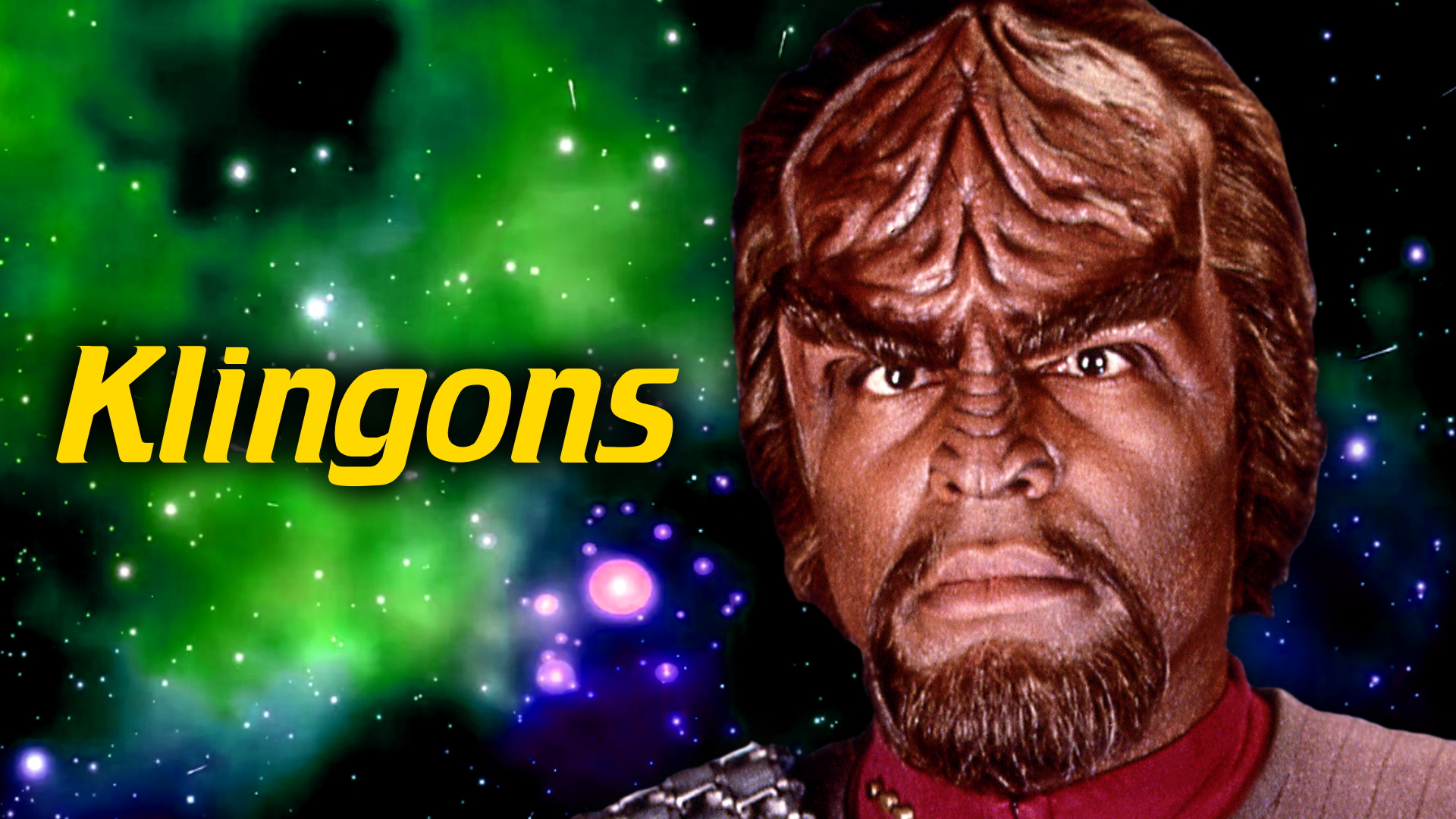Hey guys, Tyler here. If there’s any species in the Star Trek franchise that gets people real excited, it’s the Klingons. A fascinating warrior race whose name recognition is on par with the Vulcans and Romulans, the Klingons have been featured in nearly every Trek series and several films. Their culture is also far more complex than what initially meets the eye, and they have a rich history as well as a distinctive biology that sets them apart from many other species in the galaxy. Today I’ll explore the Klingons’ ancient origins and how their physiology has affected the development of their civilization.
External Features
Like other humanoid races in the Milky Way, Klingons are thought to be descended from a genetic code seeded by ancient humanoid Progenitors 4.5 billion years ago. Their sun seems to be a K-type yellow-orange star slightly cooler than Sol. The Klingon sun’s real-world equivalent has not been identified, but it’s said to be near Omega Leonis, which is about 112 light-years away. K-type stars are among the most stable in the universe and slightly longer-lived than G-type stars like our sun, meaning there’s more time for complex life to evolve in a relatively calm stellar radiation environment. This would have had a significant impact on the Klingons’ early evolution, as the redder wavelengths emitted by K-type stars would lead to slightly weaker photosynthesis. This could induce fiercer competition among Klingon ancestors.

But besides the influence from their sun, the Klingons’ evolution would have been driven by the volatile climactic conditions on their homeworld, Qo’noS. As we learn in Discovery, Qo’noS is home to a vast network of caves and subterranean volcanoes that produced intense geological activity in the past. Qo’noS is depicted in some media as having a single supercontinent, though on-screen depictions make it unclear if this is really the case. As far as atmospheric conditions, Qo’noS has thick cloud layers and dense gases in its upper atmosphere that can block long-range scans. The planet is said to have “chaotic” weather systems, marked by intense thunderstorms. Between this and the smaller amount of blue light output from their star, this could be the reason Qo’noS’ sky is green in many appearances as the atmosphere would scatter green wavelengths. But though the climate has likely changed over eons, it’s not hard to imagine that general shifts in the environment influenced important steps in Klingon evolution.
The intermediary stages of Klingon evolution are not particularly well defined except for one glimpse we get in The Next Generation episode “Genesis,” in which the Enterprise crew suffers from a virus that causes them to “de-evolve.” Now, at the risk of taking this episode too seriously, I just want to say that for years, the examples of “de-evolution” in “Genesis” have bothered me substantially. Some of them make sense, like Picard, Riker, and Nurse Ogawa transforming into proto-hominids, and perhaps Troi regressing to an amphibian, but some of the other transformations—Barclay into a spider, Data’s cat spot into a damn IGUANA…it’s too much y’all. Then there’s Worf’s transformation…into a so-called “proto-Klingon” with an exoskeleton, mandibles and pincers, and venomous sacs—quite an interesting design, indeed. This similarly used to bother me quite a bit, looking like a leap and a bound beyond what would be expected for a more-human-looking-than-not humanoid species, but then…I realized I just had to open my mind.
Trek has historically not been great with evolution—just see the Voyager episodes “Distant Origin” or “Threshold.” This “de-evolved Klingon” could be something that’s not in the Klingons’ direct evolutionary line, rather an example of a horizontal gene transfer mutation, but on the other hand, maybe it’s not so far-fetched. You see, a land-dwelling predator that possesses the traits I mentioned earlier could still tell us a lot about early Klingon evolution. The lower jaw mandibles, for example, could have easily evolved into teeth—indeed, the faces of primates have changed quite a bit over millions of years. It’s even thought that a therapsid protomammal cousin of ours called Euchambersia—which lived about 255 million years ago—may have produced venom. Additionally, the Klingons’ forehead ridges—one of the traits that has made them iconic—are undoubtedly adapted as a result of combat and mating rituals among primordial ancestors. The bony protrusions even form a part of the Klingon skull, which makes a lot of sense. Indeed, the Klingon skeleton overall would be stronger, as would their muscles, to overcome the slightly higher surface gravity of their homeworld.
The Klingons’ forehead ridges featured from The Motion Picture onward also distinguish them from their early appearances in The Original Series, which leads to a rather uncomfortable conversation that involves genetic engineering. After first contact with humanity in the early 2150s, Klingon scientists attempt to bioengineer enhanced warriors using DNA from human augment embryos left over from the Eugenics Wars. This genetic engineering backfires and creates the “augment virus”—a plague that sweeps through the empire and causes infected Klingons to lose their forehead ridges until a cure is developed decades later. This is the officially given explanation for why Klingons in The Original Series lack their forehead ridges as opposed to Klingons seen in literally every other installment (besides The Animated Series)…yep, an arguably contrived in-universe explanation for a real-world production limitation. In the DS9 episode “Trials and Tribble-ations,” when the Defiant crew travels back in time to stop an assassination plot against James T. Kirk, they see Klingons afflicted with the virus and look to Worf, who says, “We do not discuss it with outsiders.” Maybe they should’ve left it at that…I don’t know. I feel like when Gene Roddenberry had their makeup redesigned for The Motion Picture, his intent was that their new design was what they were always supposed to look like.

The matter of the Klingons’ facial appearances is also something that became a point of controversy when Star Trek: Discovery first premiered. Before departing the show, executive producer Bryan Fuller—who oversaw much of the early development for season 1—was adamant about wanting to update the Klingon makeup design. In his words, the appearance of Klingons has never been consistent across installments—a statement with some truth to it, to be sure—and Fuller aimed to introduce several different houses with different styles. I think this approach was not totally unwarranted, as—like I’ve said before—variety in a species is not a negative, but a positive, in my view. That said, I’ve never really been a big fan of the changes made to the Klingons. Among these changes are a grayer skin coloration—a departure from the more human-looking skin tones of previous installments—the inclusion of talons at the end of their fingers, and, of course, their bald heads. Now, bald Klingons are not new—General Chang in The Undiscovered Country was bald, as were the alternate reality Klingons in Star Trek Into Darkness—but Discovery took it to a whole other level.
All things considered, I think the decision to walk back the baldness in subsequent seasons was the right call. I get what they were going for originally—trying to make this alien species look more alien—but for a franchise with as much weight and history in the cultural consciousness as Star Trek, there’s a certain expectation that failing to meet will of course leave many people dissatisfied. Adding the hair back seems to be part of a perhaps ongoing process of slowly retconning the Klingons to appear more similarly to how they have traditionally looked. Using the Klingons narratively as an analogue for some of the West’s historic adversaries—from the Soviet Union and/or China in The Original Series to, perhaps, jihadists as they are portrayed in Discovery—it makes sense to portray them as an “other,” extending that “otherness” all the way to making them look more “monstrous.” But given that Star Trek is a universe where many humanoid aliens share lots of fundamental similarities with us for narrative reasons, I think it’s just as valid to portray them in a way that’s more humanizing, so to speak. Not that there’s anything wrong with introducing other pigmentations—T’Kuvma is certainly an imposing figure, and Voq being an albino Klingon and an outcast is another creative character choice. But ironically, Discovery seems to have initially limited the variety more so than other installments.
Internal Anatomy
In addition to their external attributes, Klingons’ internal physiology is equally fascinating. One of the most significant aspects of their anatomy that sets them apart is that they have multiple redundant organs, likely another feature that aids their survival in combat. Klingons are said or shown to have twenty-three ribs, two livers, an eight-chambered heart, three lungs, two stomachs, two urinary tracts, and extra neural tissue. This redundancy forms the basis of a principle called brak’lul. Some, including B’Elanna Torres, believe that these extra organs are entirely vestigial and unnecessary. In the Voyager episode “Lineage,” Torres wishes for The Doctor to remove lines of DNA from her hybrid daughter’s genetic code. But The Doctor reminds her that while many of these extra organs aren’t necessarily essential for survival, they can confer some benefits in contexts other than battle—such as extra stamina in sports.
Speaking of Klingon children, we are shown in various episodes that the gestation period for a Klingon offspring is around 30 weeks—about a month and a half shorter than the human gestation period—though it can be shorter for hybrids of certain species. This is likely because of the sheer size of the Klingons’ crania—just as with human children, once the skull reaches a certain size, they’ve gotta come out. Because of the larger brain casing in primates—our brain-to-body ratio being more conducive to intelligence, though this relationship is rather dubious—necessitates that after we are born, our parents must spend longer taking care of us before we reach maturity than animals with longer gestation times. However, once Klingons are born, they mature more quickly anyway—by one year, they reach the maturity of a human child of age four, and by eight years, they are equivalent to a human sixteen-year-old. This may be related to a faster revolution of their homeworld around their sun—though we don’t know how long a Klingon year is, exactly—but more than likely it’s simply an adaptation to the harsh conditions of their environment. Also, once they reach maturity, Klingons generally live to be 150 years old.

The color of Klingon blood has also been depicted differently in various installments. While often it is shown as being red while oxygenated under M-class conditions, notably, in The Undiscovered Country and in Discovery, it is distinctly pink. The purpose of this pink blood, despite having been originally scripted as red for The Undiscovered Country, was allegedly to appease ratings but also to show up as “distinctly alien.” As I discussed in my video about the Asari from Mass Effect, coloration of blood is in large part influenced by what kind of protein is present to facilitate oxygen transport. In humans and other vertebrates, it’s hemoglobin, which is iron-based—though Vulcans’ green blood is said to use a copper-based variant of hemoglobin. However, this is not the only protein available: in other Earth animals, particularly crustaceans—which the Klingons’ primordial ancestor seen in “Genesis” somewhat resembles—it’s hemocyanin, which is usually blue but can appear purple. Hemerythrin—found in some marine worms—is also purple. But the “crimson red” color of the blood-filled river Skral where Kahless defeated Molor means it may be closer to our own blood than that of various invertebrates. At the very least, it could be a mix of various proteins.
There are numerous additional factoids about Klingon biology that are mentioned in non-canon works, but one that stuck out to me—from the novel Pawns and Symbols—is about Klingon vision. It is revealed that Klingons are color blind in the human sense, being unable to distinguish red from black. Furthermore, their vision is said to extend into the ultraviolet, to 32 thousand Angstroms…human vision includes wavelengths between four thousand and seven thousand Angstroms. Red-black color blindness is not a conventional form of color blindness in humans or other animals, but it makes sense given that red can often appear to be very dark under certain conditions—there’s a reason, after all, that longer wavelengths outside the visible spectrum are called “infrared.” The rod and cone cells that form the basis of our retinas usually absorb and are damaged by strong UV light, but many Earth animals, especially those that lack lenses, such as insects and shrimp, can see ultraviolet colors just fine. After all, Klingon cells—having evolved around a sun that’s slightly dimmer than Sol—would need to absorb as much light as necessary to power their physiology, as would pigments found in the plant life on Qo’noS. For more about how sunlight affects the color of life, see my videos about the Asari, Cardassians, and Orions.
Final Thoughts
Klingons are among the most formidable species in the galaxy—they’re larger, they’re stronger, and they have more stamina than many other humanoid species. But besides their biology, it’s also their rich history, culture, and imperial ambitions that make them a force to be reckoned with on the interstellar stage. Clearly, all of the information we know and can speculate about the Klingons can’t fit into one fifteen-or-so minute video. Let me know what aspects of Klingon culture and society you’d like to see me cover in future videos…I’ve got some ideas, but nevertheless, I’m all ears.
Watch Orange River Media’s Video
In the meantime, thanks for watching! I’m interested to hear your thoughts in the comments. If you haven’t yet subscribed, be sure to do that as well so you won’t miss future uploads and click the bell icon to receive all notifications. If you want to support my work even further, becoming a patron at patreon.com/orangeriver is a great way to do so. I’ll see you in the next video…live long and prosper.
YouTube: https://www.youtube.com/orangeriver
Twitter: https://www.twitter.com/orangerivernw
Instagram: https://www.instagram.com/orangeriver.nw
Facebook: https://www.facebook.com/orangerivernw
Patreon: https://www.patreon.com/orangeriver












